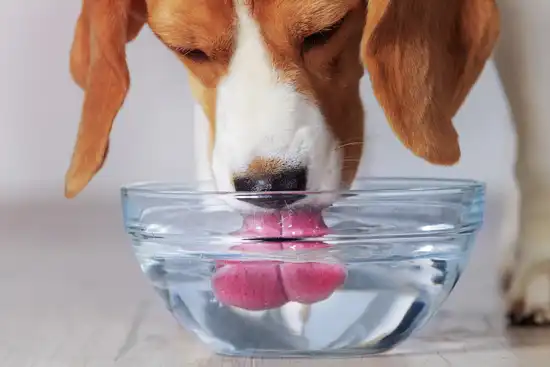Water and Your Dog's Health

When it comes to your dog's nutrition, water is even more important than protein, fat, carbohydrates, vitamins, and minerals.
Your dog's body will naturally lose water all day. They lose water as they sweat through their paws and when they pant. And they lose water when they pee and poop.
A dog that loses too much water -- just 10% to 15% of the water in their body -- can get very sick and even die. So that water they are losing need to be replaced.
How Much Water Is Enough?
A good rule of thumb: Make sure your dog gets at least 1 ounce of water daily for each pound they weigh. That means a 20-pound dog needs at least 20 ounces of water every day. That's more than 2 cups, or as much as in some bottles of water or soda.
To help you keep track of how much water your dog drinks, make a note of how high you fill their water bowl and how far the level has dropped the next day.
Keep Plenty of Water Available
Leave the water bowl where your dog can get to it easily. Since dogs can knock over the bowl while they're drinking, use one that's made to not tip and spill.
Clean the bowl daily. Refill often so the water supply stays fresh.
Whenever you and your dog are playing outdoors -- especially when it's hot -- bring cool water with you for them to drink. If your dog stays outside on hot days, add ice to the water bowl.
Some dogs are happy to drink from the toilet. But that isn't a clean source of water! Keep the toilet lid closed so your dog stays out.
Signs of Dehydration
When dogs don't drink enough water or if they lose too much water, they become dehydrated. Older dogs and dogs that are sick, pregnant, or nursing can get dehydrated easily.
Symptoms of dehydration include:
- Little energy
- No interest in eating
- Sunken eyes
- Dry mouth
You can use these two ways to quickly check your dog for dehydration, too. If the response isn't normal, it's a sign of possible dehydration:
Lift the skin on the back between your dog's shoulders. It should sink back to its normal place right away.
Gently press on your dog's gums until the pressure creates a light spot. The normal color should come back right away when you remove your finger. Also the gums should feel slick and moist.
If you think your dog might be dehydrated, take them to the vet right away.
Prevent Diarrhea in Your Dog
Many health problems can cause diarrhea, including infections from bacteria, viruses, and worms. A disease called parvovirus triggers severe vomiting and diarrhea. And because your dog will lose more water with diarrhea, diarrhea can lead to dehydration.
